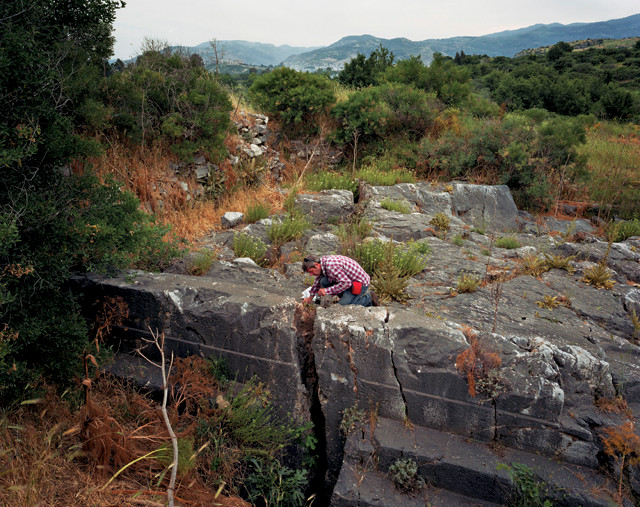
by Bethany Augliere Thursday, December 14, 2017

Iain Stewart studies the remains of a fifth-century-B.C. temple built atop a fault-formed fissure at Ephesus in western Turkey. Credit: Stephen Vaughan.
In ancient Greece, earthquakes frequently shook the ground and devastated cities and temples. But time after time, people built — and rebuilt — prominent structures near dangerous faults. How much the ancient Greeks knew about earthquakes and fault behavior is unclear. But in a new study in Proceedings of the Geologists’ Association, researchers suggest that the relationship between sacred sanctuaries and faults is more than coincidental, and that earthquakes may have had a previously underappreciated cultural significance to the ancient civilization.
Earthquakes occurred often in the carbonate-dominated karstic landscape of the Aegean region, and were well documented from the sixth through the fourth centuries B.C. by ancient scholars like Plato and Aristotle. Some of these quakes resulted in landscape features favored for development, like abundant freshwater springs and vents that released supposedly mystical, trance-inducing gases. Repeated fault movements also lifted parts of the rocky landscape from the plains, creating hilltops and steep cliffs called scarps that were beneficial as sites for fortifications or citadels to protect nearby cities.
Iain Stewart, a geologist at the University of Plymouth in England, and Luigi Piccardi, of the Institute of Geosciences and Earth Resources in Italy, pieced together evidence of eight notable sites located on faults around the ancient Aegean region, an area that includes parts of present-day Greece and Turkey. “The key point is not the number of sites in total but their prominence in Greek antiquity, with most being important cities,” Stewart says.
One well-known example is the legendary Temple of Apollo at Delphi, which, from 1400 B.C. to A.D. 400, housed the high priestesses who served as oracles. The temple sits atop limestone fractured by two intersecting faults. Natural springs rise to the surface near the faults, and it’s possible that seismic activity there released gases such as carbon dioxide, methane and ethylene from buried hydrocarbon reservoirs. In small quantities, sweet-smelling ethylene is a mild narcotic, and is known to produce feelings of euphoria. The priestesses may have inhaled these natural gases, leading to a trance-like state in which they could purportedly communicate with the gods.
“I don’t think there was a temptation originally to put temples and sanctuaries on earthquake faults. They put them on springs, and these springs would come up along the fault line,” Stewart says. “The more interesting question is: When the fault ruptured, and it suddenly wreaked havoc through the site, what was the reaction? What was the response?” In 373 B.C., an earthquake destroyed the temple at Delphi, but it was rebuilt in the same spot.
Stewart suggests that another possible example of the influence of faults and earthquakes on ancient Greece had to do with the Greeks’ connection to the underworld. For example, the sanctuary of Hades and Kore, the gods of the underworld, was built directly on the Hierapolis Fault at the ancient city of Hierapolis in western Turkey, so the fault itself may have been worshipped as the opening to the underworld. Although there is no written documentation to support this, Stewart notes, “there is a clear trace of a ground rupture on the Hierapolis Fault.”
Not every ancient Greek sanctuary is built on an active fault, although it does seem to be the case, more often than not, based on current knowledge, says Simon Jusseret, a geoarchaeologist from the University of Texas at Austin who was not involved in the study. Ancient sites sit on faults around the world, he notes, and people have studied the relationship between archaeology and earthquakes before. What makes this study innovative, he says, is that the researchers “weave together archaeological and geological evidence to provide a compelling case … that earthquakes and associated ground ruptures had a prominent role in ancient Greek culture, and participated in structuring its ritual landscape.”
In the past, acquiring information about earthquakes from archaeological sites has been very opportunistic, Jusseret says. “Stewart is showing that we might learn something about ancient cultures based on earthquake evidence — how they reacted to these earthquakes, how they incorporated geomorphology into their daily lives or into their mythology,” he says.
Stewart says he hopes the relationship between earthquakes and ancient cultures is something scientists will explore further, particularly in other regions like Asia, the Middle East and South America. “The way we see earthquakes today … is as these intensely destructive events,” Stewart says. However, he adds, earthquakes aren’t entirely negative. “They create landscapes within which humans have evolved, and therefore they are really important parts of the human story.”
© 2008-2021. All rights reserved. Any copying, redistribution or retransmission of any of the contents of this service without the expressed written permission of the American Geosciences Institute is expressly prohibited. Click here for all copyright requests.